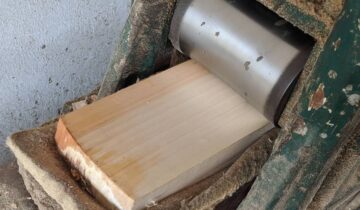Cricket Bat Pressing: The Hidden Science Behind Performance
Cricket Bat Pressing: The Hidden Science Behind Performance When players evaluate a cricket bat, they often focus on grains, balance, and weight. But one of the most critical—and often misunderstood—elements in the bat-making process is pressing. It’s a technique that transforms a raw cleft of willow into a match-winning blade. Done right, pressing enhances performance, sweet spot responsiveness, and durability. Done wrong, it can ruin a bat before it ever hits a ball. In this post, we break down the what, why, and how of bat pressing, and explain why serious cricketers should care. 🏏 What Is Pressing in Cricket Bat Making? Pressing is the process of compressing the face and edges of the willow cleft using heavy rollers. This mechanical treatment tightens the wood fibers, making the bat: Stronger More responsive Ready to handle high-impact cricket balls Pressing is usually done before shaping and finishing. It’s one of the first and most critical steps in turning raw English or Kashmir willow into a cricket bat. 🔍 Why Is Pressing Important? Here’s why pressing can make or break your bat: 1. Durability Pressing strengthens the blade, making it more resilient to ball impact. Reduces risk of cracks, splits, and edge damage. 2. Sweet Spot Activation The better the pressing, the wider and more responsive the sweet spot becomes. 3. Energy Transfer A well-pressed bat delivers better power with less effort. Poor pressing leads to “dead” zones on the bat face. 4. Reduced Knocking-In Time Professionally pressed bats require less manual knocking before play. Saves time and ensures consistency. 🧪 Types of Bat Pressing 1. Hand Pressing Traditional method using a manually operated press. Common in small-scale or custom bat production. Offers maximum control over pressure and area coverage. 2. Machine Pressing Uses hydraulic or mechanical roller presses. More consistent pressure but can lack finesse. Used by most major manufacturers to save time. 3. Cold Pressing vs Hot Pressing Cold Pressing: Standard method, applies pressure at room temperature. Hot Pressing: Less common, involves slight heating to increase fiber flexibility. At Machine Cricket, we use precision-controlled hand and hydraulic pressing to ensure optimal blade responsiveness. ⚖️ The Art of Balance: Not Too Hard, Not Too Soft Pressing is a delicate balance. Here’s what happens at both extremes: Pressing Level Result Impact on Performance Under-Pressed Soft face, big grains visible Good initial ping, but fragile Well-Pressed Balanced compression, compact grains Durable, responsive, long-lasting Over-Pressed Too hard, dull feel Safe but lacks power and ping 🛠️ Pressing & Bat Grades: The Relationship While higher-grade willow (e.g., Grade 1 English Willow) naturally performs better, even top-grade bats can underperform if poorly pressed. That’s why some Grade 3 bats—if pressed properly—can outperform higher grades from mass-produced brands. 👉 A bat’s performance depends more on pressing quality than on the number of grains. 🧠 Signs of a Well-Pressed Bat Uniform surface across the face Slightly compacted grains (not too open or squished) Consistent rebound in sweet spot and edges Slight curvature remains (pressing doesn’t flatten bow) You can test the ping with a mallet or a ball—a well-pressed bat will rebound crisply with minimal effort. ⏱️ Does Pressing Replace Knocking-In? No. Pressing and knocking-in are complementary steps. 🔄 Pressing: Compresses the bat in the factory Prepares the structure of the bat 🔨 Knocking-In: Further conditions the bat surface Customizes the face to ball impact patterns However, a well-pressed bat reduces knocking time by 50–70% and allows you to start using it in nets sooner. 🧰 How Machine Cricket Presses Every Bat At Machine Cricket, pressing isn’t just a checkbox — it’s a scientific process customized per bat profile: ✅ Computer-calibrated pressure settings ✅ Variable roller density for different willow grades ✅ Manual finishing for edges and toe area ✅ Each bat individually tested for ping before dispatch That’s why Machine Cricket bats consistently deliver power, ping, and longevity — whether it’s Grade 1 or Grade 5. ❓FAQ: Common Questions About Pressing Q: Can I re-press an old bat? A: Not recommended. Once the fibers are damaged or separated from impact, re-pressing may not fix structural issues. Q: Should I oil the bat before or after pressing? A: After pressing. Oiling softens fibers; pressing needs firm wood. Q: Why do some pressed bats still break? A: Overuse, poor maintenanceand its natural nature of willow that still lead to breakage—pressing reduces risk, not eliminates it. 🏁 Final Thoughts Pressing is the unsung hero of bat manufacturing. A properly pressed bat won’t just feel better—it will last longer, perform more consistently, and help you play with confidence. Whether you’re buying your first English Willow or upgrading to a custom piece, make sure you’re asking the question: “How is this bat pressed?” At Machine Cricket, every bat is performance-pressed, not just pre-pressed. 📌 Key Takeaways Pressing enhances power, durability, and ping. Hand and hydraulic pressing offer the best results. Under-pressed bats break; over-pressed bats feel dead. Machine Cricket applies custom pressing for every cleft. 🔗 Shop Performance-Pressed Bats Browse the latest English Willow bats at MachineCricket.com, crafted with precision pressing technology trusted by top-level players. Would you like the SEO meta title and description for this post next?




 No products in the cart.
No products in the cart. 